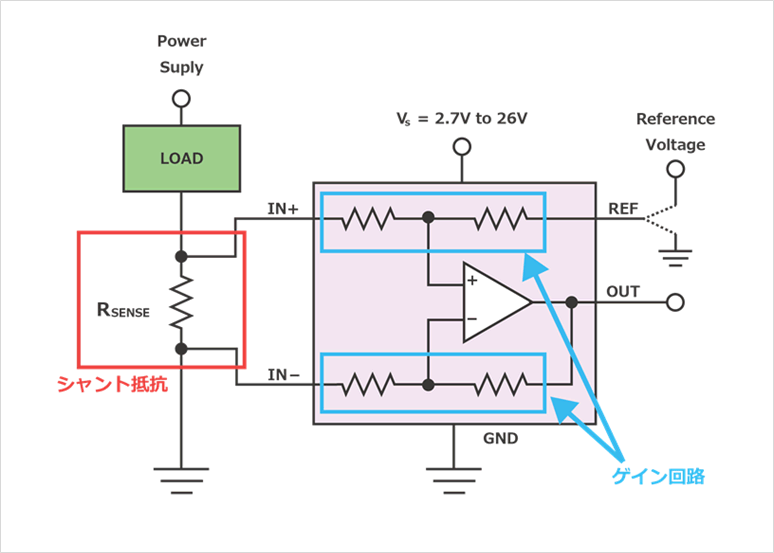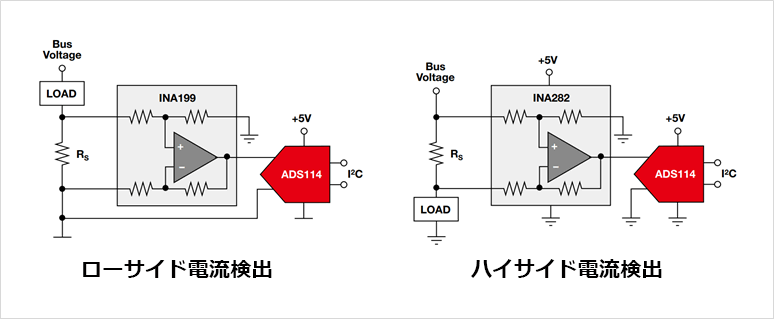Current sensing required in every field
Mobile products such as smartphones, and home appliances such as PCs and TVs. Industrial equipment such as factory automation, communication equipment, automobiles, medical equipment, and even aircraft. There is a growing need for "current sensing" in many areas of electronics applications today.
Accurate "current sensing" is important to ensure application safety, and current and power management are essential to improving system efficiency.
Furthermore, in most application fields, miniaturization and high performance are required for equipment, and circuit designers are puzzled about how to incorporate a high-precision current detection circuit in a small board area.
There are several methods of "current detection", and it is important to understand the advantages and disadvantages of each method and find the best method for the circuit you are designing.
How does a current sense amplifier measure current?
When a current flows through a resistor, a voltage is generated according to Ohm's law, but the current sense amplifier detects the current by measuring the voltage across the resistor. A resistor for detecting current is called a "shunt resistor".
Increasing the value of the shunt resistor increases the power loss (I^2 x R) proportional to the square of the flowing current, so decreasing the value saves power. Since it is the input of the built-in operational amplifier (differential amplifier), the offset of the operational amplifier is a concern.
In addition, although the voltage across the shunt resistors depends on the shunt resistance value, the differential voltage is usually small.

Do you want to assemble with discrete components? Adopt a dedicated IC?
There are several ways to achieve "current sensing". The typical method so far has been to use a discrete op amp. By using a dedicated IC "current sense amplifier", it is possible to achieve "miniaturization", "high precision", "reduction of design man-hours" and "reduction of parts" of the current detection circuit.
Current sense amplifiers are already in use in a wide variety of electronics applications, including motor and solenoid control, actuator control, battery life indicators, overcurrent protection and monitoring circuits, DC/DC converters, factory automation, medical diagnostics, and notebook PCs. It is utilized.
Four Benefits of Using a Current Sense Amplifier
The advantages of using a current sense amplifier are the following four points.
Built-in gain circuit
Various gain options (eg, 20, 50, 100, 200V/V, etc.) are available without the need to prepare a gain circuit with external resistors. It also includes a precision-matched resistive gain circuit for stable performance over temperature and process variations.
Large common mode voltage range (input DC voltage range referenced to GND)
Op amps are basically incapable of inputting voltages higher than the supply voltage, but current sense amplifiers are designed to support input voltages that exceed the supply voltage range.
Example: INA282 supports common-mode voltages from -14 to +80V with a 2.7V supply
Small offset of built-in amplifier
Conventionally, a large value shunt resistor is used to increase the measured voltage drop to reduce the impact of high offset on the op amp, but using an op amp with a small offset (e.g. 10uV) improves measurement accuracy at low currents and allows the use of low value shunt resistors to improve system efficiency.
temperature stability
Because all gain-setting resistors are internal with the op amp, temperature drift is low and consistent. This enables robust current measurements over the entire specified temperature range.
Choosing the best measurement method based on the features ~Low-side current detection and high-side current detection~
The "current sense amplifier" has different measurement methods depending on where the shunt resistor is placed. The method of placing a resistor between the load and ground (GND) is called "low-side current sensing," and the method of placing a resistor between the power supply and the load is called "high-side current sensing."

Both measurement methods have advantages and disadvantages.
Advantages of low-side current sensing
One advantage of low-side current sensing is that the common-mode voltage is near zero. This simplifies the design of the application circuit and the device selection for this measurement.
Because the voltage seen by the current sense amplifier is close to ground, this method of current measurement is preferred when dealing with very high voltages or in applications where supply voltages are prone to spikes and surges.
Low-side current sensing is also widely used in automotive, industrial, and telecom applications due to its ability to withstand high voltage spikes and its ability to monitor current in high voltage systems.
Disadvantages of low-side current sensing
The main drawback of low-side current sensing is that the voltage drop across the shunt resistor appears differential between power ground and load/system ground. This can be a problem if other circuits reference power ground. To minimize this problem, all circuits that interact should reference the same ground. A small shunt resistor value minimizes the ground shift.
The advantages/disadvantages of high-side current sensing are the exact opposite of low-side current sensing
The advantages and disadvantages of high-side current sensing are the exact opposite of low-side current sensing. The table is as follows.
| merit | Demerit | |
| Low side current sensing |
|
|
| High side current sensing |
|
|
"Current sense amplifier" to improve system efficiency
A "current detection amplifier" that protects the system from wiring shorts and overcurrents and improves system efficiency. Various companies have released various products, but Texas Instruments (hereafter, TI) has three types, analog output type, built-in comparator type, and digital output type, and also has a built-in shunt resistor. There are products, and new products are being released one after another.
Please visit TI's information site where you can quickly find the optimal "current sense amplifier" for the circuit you are planning to develop, and take a look at our wide range of products.
http://www.tij.co.jp/ja-jp/amplifier-circuit/current-sense/overview.html
We also have extensive documentation on current sensing. Why don't you take advantage of this too?
http://www.tij.co.jp/ja-jp/amplifier-circuit/current-sense/overview.html#technical-resources
Click here for recommended articles/materials
Three features of zero-drift nanopower operational amplifiers

